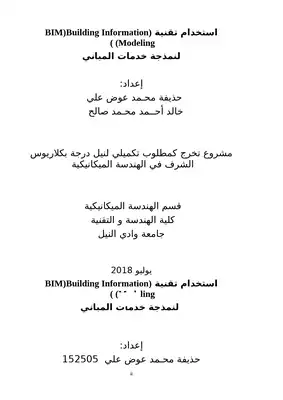وصف الكتاب
الهدف من المشروع هو استخدام تقنيةBuilding Info r mation Modeling) ) (BIM) لنمذجة خدمات المباني حيث من خلالها تم تصميم أعمال التكييف والتجهيزات الصحية وعرض البيانات التصميمية.
مع التوجه العالمي نحو المباني الخضراء أو المستدامة تظهر الحوجة إلي تقنيات جديدة تمكن من تصاميم تلبي معايير هذا التوجيه، نجحت تقنية نمذجة المعلومات في ان تنقل عالم البناء الى مستوي جديد من التطوير وظهرت أهميتها في توفير الوقت والمال من خلال الأكتشاف المبكر للأخطاء والتنسيق الجيد بين اطراف المشروع من مصممين ومهندسين ومقاولين ومالكين.
يحتوي المشروع على خمسة فصول , يتناول الفصل الأول نبذة تاريخية عن التقنية واهم المميزات والمحددات والمفاهيم الأساسية للتقنية والأدوات البرمجية ومقارنة بين نمذجة معلومات البناء(BIM) والتصميم بمساعدة الحاسب (CAD) ويلقي الضوء على مستقبل التقنية
ويحتوي الفصل الثاني على الأعمال الميكانيكية والتجهيزات الصحية التي تتم في المباني بصورة عامة
يشتمل الفصل الثالث علي نظرة شاملة لتنفيذ الأعمال الميكانيكية والتجهيزات الصحية والكهربائية بتقنية نمذجة معلومات البناء (BIM).
أما الفصل الرابع فقد سلط الضوء على دراسة الحالة حيث تم تناول ماقد تم تنفيذه من أعمال التكييف والتجهيزات الصحية في النموذج.
واخيرا الفصل الخامس يتناول الخلاصة والتوصيات.
و خلص من الدراسة التي تمت للنموذج أن تقنية (BIM) وبرنامج النمذجة والتحليل (Revit 2015) قد وفر بيئة مثالية لنمذجة خدمات المباني أفضل من تلك المتوفرة في بيئة الـ (CAD).
Abstract:
The objective of the project is to use Building Info r mation Modeling (BIM) to model building services, through which air conditioning, sanitary equipment a nd design data are designed.
With the global trend towards green o r sustainable buildings, the need fo r new technologies that enable designs to meet the sta ndards of this guidance has been demonstrated. Info r mation modeling technology has moved the construction wo r ld to a new level of development a nd has become impo r tant in saving time a nd money through early detection of erro r s a nd good coo r dination between parties. The project consists of designers, engineers, contracto r s a nd owners.
The project consists of five chapters. The first chapter deals with a histo r y of technology, the most impo r tant features, limitations a nd basic concepts of technology a nd software tools, a nd a comparison between BIM a nd CAD. It highlights the future of technology.
The second chapter contains the mechanical wo r k a nd sanitary equipment in the buildings in general
Chapter 3 contains a comprehensive overview of the implementation of mechanical, electrical a nd electrical equipment using BIM.
Chapter 4 highlighted the case study, which dealt with the implementation of the adaptation a nd sanitary equipment in the model.
Chapter 5 deals with the conclusion a nd recommendations.
The study concluded that BIM a nd Revit 2015 provided an ideal environment fo r modeling building services better than those available in the CAD environment.
